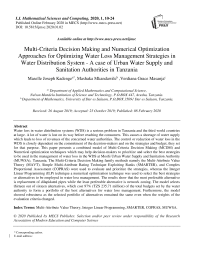Multi-Criteria Decision Making and Numerical Optimization Approaches for Optimizing Water Loss Management Strategies in Water Distribution System - A case of Urban Water Supply and Sanitation Authorities in Tanzania
Автор: Maselle Joseph Kadenge, Mashaka Mkandawile, Verdiana Grace Masanja
Журнал: International Journal of Mathematical Sciences and Computing @ijmsc
Статья в выпуске: 1 vol.6, 2020 года.
Бесплатный доступ
Water loss in water distribution systems (WDS) is a serious problem in Tanzania and the third world countries at large. A lot of water is lost on its way before reaching the consumers. This causes a shortage of water supply which leads to loss of revenues of the concerned water authorities. The control or reduction of water loss in the WDS is closely dependent on the commitment of the decision-makers and on the strategies and budget, they set for that purpose. This paper presents a combined model of Multi-Criteria Decision Making (MCDM) and Numerical optimization techniques which may help decision-makers to prioritize and select the best strategies to be used in the management of water loss in the WDS at Moshi Urban Water Supply and Sanitation Authority (MUWSA), Tanzania. The Multi-Criteria Decision Making family methods namely the Multi-Attribute Value Theory (MAVT), Simple Multi-Attribute Rating Technique Exploiting Ranks (SMARTER), and Complex Proportional Assessment (COPRAS) were used to evaluate and prioritize the strategies, whereas the Integer Linear Programming (ILP) technique a numerical optimization technique was used to select the best strategies or alternatives to be employed in water loss management. The results show that the most preferable alternative is replacement of dilapidated pipes while the least preferable alternative is network zoning. The model selects thirteen out of sixteen alternatives, which cost 97% (TZS 235.71 million) of the total budgets set by the water authority to form a portfolio of the best alternatives for water loss management. Furthermore, the model showed robustness as the selected portfolio of alternatives remained the same even when the weights of the evaluation criteria changed.
Multi-Attribute Value Theory, Integer Linear Programming, SMARTER, COPRAS, MUWSA
Короткий адрес: https://sciup.org/15017134
IDR: 15017134 | DOI: 10.5815/ijmsc.2020.01.02
Список литературы Multi-Criteria Decision Making and Numerical Optimization Approaches for Optimizing Water Loss Management Strategies in Water Distribution System - A case of Urban Water Supply and Sanitation Authorities in Tanzania
- Makaya, E. (2016). Water loss management strategies for developing countries.
- Ndunguru, M. G. and Hoko, Z. (2016). Assessment of water loss in Harare, Zimbabwe. Journal of Water, Sanitation and Hygiene for Development. 6(4): 519-533.
- Mosha, H. D. (2014). Effects of Water Pipe Burst on water quality and non revenue water in Arusha city: a case study of AUWSA. The Open University of Tanzania.
- Mahoo, H., Simukanga, L. and Kashaga, R. (2015). Water resources management in Tanzania: Identifying research gaps and needs and recommendations for a research agenda. Tanzania Journal of Agricultural Sciences. 14(1):
- SELEK, B., ADIGÜZEL, A., İRİTAŞ, Ö., KARAASLAN, Y., KINACI, C., MUHAMMETOĞLU, A. and MUHAMMETOĞLU, H. (2018). Management of water losses in water supply and distribution networks in Turkey. Türkiye Su Bilimleri ve Yönetimi Dergisi. 2(1): 58-75.
- Charalambous, B., Foufeas, D. and Petroulias, N. (2014). Leak detection and water loss management. Water Utility Journal. 8(25-30.
- Adali, E. A. and Işık, A. T. (2016). Air conditioner selection problem with COPRAS and ARAS methods. Manas Sosyal Araştırmalar Dergisi. 5(2): 124-138.
- Mulliner, E., Malys, N. and Maliene, V. (2016). Comparative analysis of MCDM methods for the assessment of sustainable housing affordability. Omega. 59(146-156.
- Banihabib, M. E., Hashemi-Madani, F.-S. and Forghani, A. (2017). Comparison of Compensatory and non-Compensatory Multi Criteria Decision Making Models in Water Resources Strategic Management. Water Resources Management. 31(12): 3745-3759.
- Cambrainha, G. M. and Fontana, M. E. (2018). A multi-criteria decision making approach to balance water supply-demand strategies in water supply systems. Production. 28(
- Vafaei, N., Ribeiro, R. and Camarinha-Matos, L. (2016). Normalization Techniques for Multi-Criteria Decision Making. THE EWG-DSS. 23-25.
- Mukhametzyanov, I. and Pamucar, D. (2018). A sensitivity analysis in MCDM problems: A statistical approach. Decision making: applications in management and engineering. 1(2): 51-80.
- Fontana, M. and Morais, D. (2016). Decision model to control water losses in distribution networks. Production, 26 (4), 688-697.
- Barfod, M. B. and Leleur, S. (2014). Multi-criteria decision analysis for use in transport decision making.
- Mousavi-Nasab, S. H. and Sotoudeh-Anvari, A. (2017). A comprehensive MCDM-based approach using TOPSIS, COPRAS and DEA as an auxiliary tool for material selection problems. Materials & Design. 121(237-253.
- Sureeyatanapas, P. (2016). Comparison of rank-based weighting methods for multi-criteria decision making. Engineering and Applied Science Research. 43(376-379.
- Volvačiovas, R., Turskis, Z., Aviža, D. and Mikštienė, R. (2013). Multi-attribute selection of public buildings retrofits strategy. Procedia Engineering. 57(1236-1241.
- Mondal, S., Kuila, S., Singh, A. K. and Chatterjee, P. (2017). A complex proportional assessment method-based framework for industrial robot selection problem. Int J Res Sci Eng. 3(368-378.
- Ghosh, S. K., Zoha, N., Chowdhury, T. Z. and Ahmmed, M. S. (2018). Supplier Selection using Integer Linear Programming Model. Global Journal of Research In Engineering.
- Goodridge, W. S. (2016). Sensitivity analysis using simple additive weighting method. International Journal of Intelligent Systems and Applications. 8(5): 27.
- Triantaphyllou, E. (2000). A Sensitivity Analysis Approach for MCDM Methods Multi-criteria Decision Making Methods: A Comparative Study (pp. 131-175): Springer.


